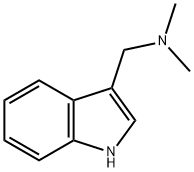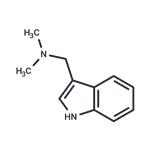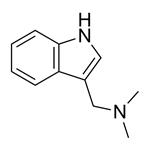Chemical Properties
?3-(Dimethylaminomethyl)indole [87-52-5], gramine, C11H14N2, Mr 174.25, mp 138 – 139 ℃, forms colorless needles. The compound is soluble in ethanol, diethyl ether, and chloroform and insoluble in water. It can be synthesized from indole by the Mannich reaction with dimethyl-amine and formaldehyde. Gramine is used to synthesize D,L-tryptophan, the plant growth regulators indole-3-acetic acid and indole-3-butanoic acid as well as the intermediate tryptamine.
Uses
Reactant for preparation of:
- Dopamine D2 receptor antagonists
- Anti-malarial drugs
- 5-indolyl-Mannich bases
- Proliferation inhibitors
- Inhibitors of human mast cell chymase
- Preparation of DL-tryptophan
- Potential detoxification inhibitors of the crucifer phytoalexin brassinin
- 3-vinylindoles
- Serotonin 5-HT6 receptor ligand templates
- Selective protein kinase c delta (PKCδ) down regulators
Definition
ChEBI: Gramine is an aminoalkylindole that is indole carrying a dimethylaminomethyl substituent at postion 3. It has a role as a plant metabolite, a serotonergic antagonist, an antiviral agent and an antibacterial agent. It is an aminoalkylindole, an indole alkaloid and a tertiary amino compound. It is a conjugate base of a gramine(1+).
General Description
This substance is a primary reference substance with assigned absolute purity (considering chromatographic purity, water, residual solvents, inorganic impurities). The exact value can be found on the certificate. Produced by PhytoLab GmbH & Co. KG
Purification Methods
Crystallise gramine from diethyl ether, ethanol or acetone. It sublimes at 59o/0.001mm. The hydrochloride crystallises from EtOH/Et2O with m 190.5-191.0o(dec). [Culvenor et al. Aust J Chem 17 1301 1964, Beilstein 22 III/IV 4302, 22/10 V 25.]







